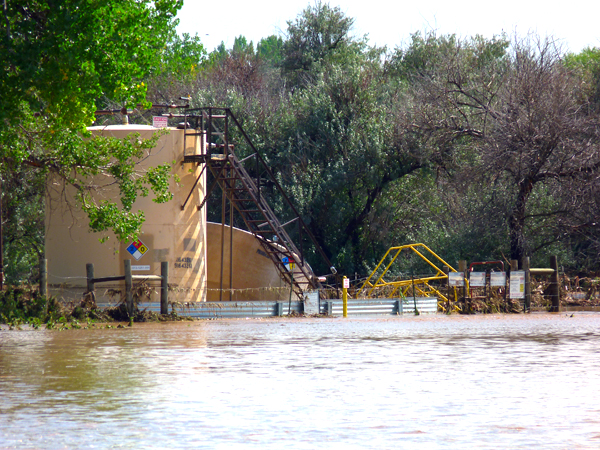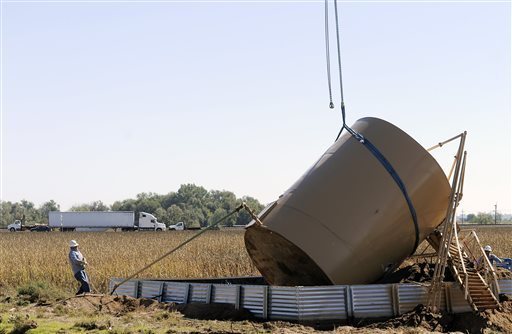Black Elk Energy is the lead proponent of the Rigs-to-Reefs program….. Richard Charter
http://www.rigzone.com/news/oil_gas/a/129120/Black_Elk_Incident_Reminder_of_Dangers_from_Hazardous_Vapors
by Karen Boman|
Rigzone Staff|
Wednesday, September 18, 2013
The November 2012 explosion at a Black Elk Energy-operated platform – which resulted from welders welding onto a pipe leading to a wet oil tank – serves as a reminder of the importance of educating workers on the dangers fire or explosions sparked by hazardous vapors, an offshore safety official told Rigzone.
A third party investigation found that the explosion and fire that occurred resulted from contractors failing to follow standard safety practices. Black Elk last month published the results of the investigation into the explosion and fire that killed three workers at the platform at West Delta Block 32 in the U.S. Gulf of Mexico.
The wet oil tank and pipework would have contained hydrocarbon gases that could have easily been ignited by an ignition temperature as the weld heat generated inside the pipe, said Tony Scott, general manager for the OCS Group, in an interview with Rigzone.
“If the workers knew more about the dangers around them the fatalities may well have been avoided,” said Scott.
To address part of this potentially fatal shortfall in training, the OCS Group now offers a Complex Mechanical course for mechanical workers. However, Scott believes that satisfactory Zone awareness training should be offered to all rig personnel throughout the industry.
A hazardous area is considered to be an area where an explosive atmosphere is or may be expected to be present. Thirty-five percent of rigs and drillships offshore will have this area broken down into zones or divisions. Zone Zero, potentially the most hazardous of the three risk areas mentioned, is where an explosive gas/vapor is present continuously for long periods. Zone Zero is not typically found on a rig, but in refineries and chemical plants; a Zone Zero can be found inside a tank where a gap exists at the top and vapor is trapped.
Zone 1 is where an explosive gas/vapor is likely during normal operation; with Zone 1, gas will be present but it is diluted by air. Zone 2, the least potentially hazardous of the three risk areas mentioned – is where an explosive gas/vapor is unlikely to occur in normal operation. If an explosive gas/vapor does occur in Zone 2, it is likely to do so infrequently and existing for short periods. Zone 2 accounts for approximately 28 percent of the total hazardous area of the rig.
Sources of accident ignition include welding, burning and static, which can occur even through nylon clothes. Welding activity could generate an ignition that could be considered an ignition temperature, or when material ignites without an external source of ignition such as a spark. This type of ignition could cause the gas/vapor inside a pipe to explode if someone was welding on the pipe.
“People erroneously assume that a spark is needed to cause ignition but this is not the case,” Scott noted. “When a spark causes ignition, this is called the Flash Point and is different to an ignition temperature. A Flash Point is where the minimum temperature at which a substance gives out sufficient vapor to form an explosive atmosphere is reached. A spark from an aluminum ladder on a rusty beam could generate a Flash Point and cause a gas or vapor to explode.”
The problem with hazardous areas is that offshore workers can be unaware that they are entering a potentially explosive area. Electricians and electronic technicians are likely to have received training to gain a full understanding of the hazardous area zones and their importance where electrical equipment is concerned. However, the rig safety preparatory courses offered to many other groups of rig workers, including welders, mechanics, scaffolders, and riggers, don’t give workers adequate in-depth knowledge of the rig zones and their potential for explosive gases and vapors.
The courses available for offshore workers are good but lightweight on hazardous vapors, an area that Scott feels has been almost neglected in training.
“You almost need separate, half day training session to talk on the dangers of vapors,” Scott commented.
While workers are trained to find muster stations in case of a fire, workers with backgrounds outside of electrical/instrumentation jobs are not given enough training in recognizing the dangers of hazardous vapors, Scott noted. The lack of understanding surrounding hazardous areas presents an issue for both offshore and onshore oil and gas facilities.
For example, a rigger going into a hazardous area on and offshore rig and breaking a junction box while trying to use the box as a foothold. These workers need to be warned on the dangers of a spark.
Scott said it wasn’t clear whether the pipe that blew up on the Black Elk platform was in a zoned area. If it was located in a zoned area, it would likely have had a hot work permit and controls to guard against sparks.
“All it takes is for a spark or hot surface to explode,” said Scott. “People don’t and should understand these hazards.”
Better training and better systems for conveying the dangers of hazardous vapors are definitely needed to fill the knowledge gap. While regulations in the U.S. Gulf of Mexico have tightened since the Macondo incident, in Scott’s opinion, the oil and gas industry is not doing enough to alert workers to the dangers of hazardous vapors, beyond the training and electrical and mechanical inspections. The failure of the Deepwater Horizon rig’s blowout preventer was the root but not the cause of the Macondo incident. Instead, the rig blew because gas that was floating around the rig found a spark or a hot surface.
Besides training, another option could be for rigs to clearly inform workers when they are entering a hazardous area which has zones or divisions that could be explosive, such as the signs used in European Union rigs under the Potentially Explosive Atmospheres Directive (ATEX). The directive, which came out in 2003, established what equipment and work environment is allowed in an explosive atmosphere in order to protect employees from explosion risk.
“I would love to go onto a rig and know that I’m going into a hazardous area,” Scott commented, noting that the times he’s been on offshore rigs, he’s found out about a rig’s hazardous areas by accident.
OCS has done one course for the Bureau of Safety and Environmental Enforcement (BSEE) and will conduct another course for BSEE on ignition sources and hazardous areas.
The company has recommended to the Coast Guard a collection of information needed to demonstrate that certain specific requirements have been undertaken with U.S. Gulf and international requirements. The document proposed would contain electrical equipment in hazardous locations documents contain data on previous inspections and maintenance of electrical equipment. The document also would contain Hazardous Area Equipment Register (HAER), supplied by a third party, including Remedial Actions, an Emergency Shut Down register, also supplied by a third party.
The document in the form proposed by OCS also would include:
* A register of Hazardous Areas qualified staff certified by the American Petroleum Institute, International Association of Drilling Contractors, or CompEx
* Mobile Offshore Drilling Unit or Vessel Hazardous Area classification drawings
* Record of Special X conditions for any equipment marked accordingly with certificates of reference
* Notified incident records within the Hazardous Areas and any potential gas/vapor catastrophes outside of Hazardous Areas
* Details of Fire, First Aid and Rescue Services
* Emergency Shut Down register, supplied by a third party
The dossier would be held on the rig or vessel and be easily accessible by the Coast Guard when they visit. The company that operates the rig or vessel or a third party would maintain the data, which would be introduced into the companies’ quality system. The data could be compiled on certified table so the Coast Guard could check against any of the items on the Hazardous Area Equipment Register.
Under the current Safety and Environmental Management Systems (SEMS) 2 requirements, a third party audit of offshore rigs and vessels. The SEMS II final rule enhances the original SEMS rule, or Workplace Safety Rule, issued in October 2010.
SEMS II was passed to provide greater protection by supplementing operators’ SEMS programs with employee training, empowering field level personnel with safety management decisions and strengthening auditing procedures by requiring third parties to conduct auditing activities. The U.S. Coast Guard’s role with SEMS II is to act as police, following up with visits to rigs and vessels to ensure that third party audits have been conducted.
“As a company that performs Ex inspections, in our experience, we know that sometimes Remedial Action’s aren’t closed out,” OCS said in an Aug. 22 letter to the Coast Guard.
In June of this year, the Coast Guard proposed to amend the electrical engineering regulations for electrical installations in hazardous areas that would expand the list of acceptable national and international explosion protection standards. The IEC System for Certification to Standards relating the equipment for use in Explosive Atmospheres also would be added as an acceptable independent third-party certification system for testing and certifying electrical equipment.
The proposed regulations would apply to foreign and U.S. mobile offshore drilling units, floating facilities and vessels that engaged in activities on the Outer Continental Shelf for the first time after the regulations’ effective date. They would also allow owners and operators of U.S. tank vessels to choose the compliance regime in existing regulations on the proposed regulations.
When the ATEX Directive came out in Europe in 2003, complaints arose that equipment had to be classed as in service to be used. What started to happen was that equipment that would be used in non-risk areas could be certified by the company. The self-certification was good for mechanical people. But the ATEX self-certification process slipped out of Europe into the United States, Scott noted. This led to confusion on the Coast Guard’s behalf that companies would self-certify equipment for Zone 2 work, not only mechanical but electrical equipment as well.
Karen Boman has more than 10 years of experience covering the upstream oil and gas sector. Email Karen at kboman@rigzone.com.
Special thanks to Richard Charter



